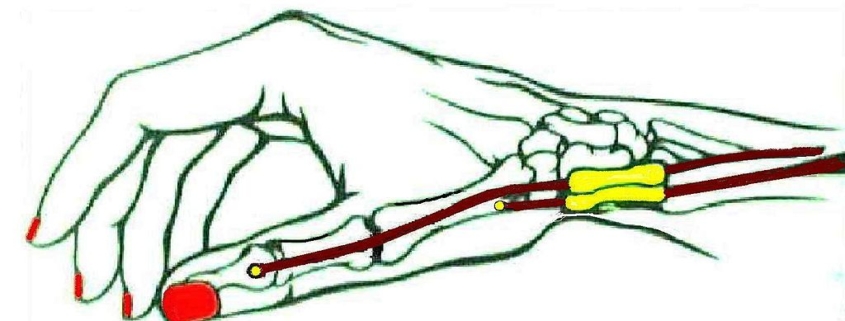
de Quervain’s Tenosynovitis
Overview
de Quervain’s Tenosynovitis is a common medical condition affecting the tendons on the thumb side of your wrist. If you have de Quervain’s tenosynovitis, it can be painful to make a fist, grasp or pinch things, or turn your wrist. It is most commonly found in middle-aged women and those who are pregnant, but can occur in anyone.
Types
There are no subtypes of de Quervain’s tenosynovitis. It is a specific condition that affects two tendons on the thumb side of your wrist.
Causes
The cause of de Quervain’s tenosynovitis is not always clear. It can sometimes arise due to overuse of the wrist, especially in activities that involve twisting and gripping. Some individuals may also be genetically predisposed to this condition. Pregnancy and rheumatoid arthritis can also increase the chances of developing this condition.
Symptoms
The main symptom of de Quervain’s tenosynovitis is pain on the thumb side of the wrist. The pain may appear either gradually or suddenly and could move up your forearm. The condition can also cause swelling and a “sticking” sensation in the thumb. Performing activities that involve pinching or grasping can exacerbate the discomfort.
Diagnosis
A healthcare professional will diagnose de Quervain’s tenosynovitis based on the symptoms and a physical examination of the hand and wrist. One common test is the Finkelstein test, wherein you bend your thumb across your palm, bend your fingers down over your thumb, and then bend your hand toward your little finger. If this causes pain on the thumb side of the wrist, it’s likely de Quervain’s tenosynovitis.
Treatment Options
There are several options for treating de Quervain’s tenosynovitis:
-
- Conservative treatments include rest, thumb spica splinting, and nonsteroidal anti-inflammatory drugs (NSAIDs).
-
- Physical therapy can improve range of motion and reduce pain.
-
- Corticosteroid injections into the tendon sheath can help reduce swelling and pain.
-
- If non-surgical interventions don’t produce desired results, surgery to release the thumb tendons may be considered.
Living With de Quervain’s Tenosovitis
Living with de Quervain’s tenosynovitis can require some adjustments. Here are some practical tips to manage the condition:
-
- Rest: Giving your wrist a break from activities that worsen symptoms can help speed recovery.
-
- Pain management: Over-the-counter pain relief can help manage discomfort. If your doctor prescribes medication, ensure you take it as directed.
-
- Exercise: Gentle exercises can improve your hand’s range of motion and reduce stiffness.
-
- Splinting: A splint or brace can offer support to the thumb and wrist, and limit movement that might aggravate pain.
When to Seek Help
If you are experiencing persistent pain, swelling, or difficulty moving your thumb or wrist, you should urgently seek medical help. Rapid onset of pain, loss of function or deformity in your thumb or wrist requires immediate attention. This is especially true if your symptoms worsen despite conservative treatments. Your healthcare provider can guide you on the next steps, whether that’s medication, physical therapy, or in some cases, surgery. Remember, early intervention often leads to more effective treatment.
